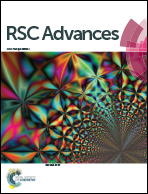TLC-smartphone in antibiotics determination and low-quality pharmaceuticals detection†
Abstract
Thin layer chromatography (TLC) is a powerful and simple technique for screening and quantifying low quality and counterfeit pharmaceutical products. The detection methods used to detect and quantify separate analytes in TLC ranges from the densitometric method to mass spectrometric or Raman spectroscopic methods. This work describes the development and optimization of a simple and sensitive TLC method utilizing a smartphone CCD camera for verification of both identity and quantity of antibiotics in dosage form, namely ofloxacin and ornidazole. Mixtures of ofloxacin and ornidazole were chromatographed on a silica gel 60 F254 plate as a stationary phase. The optimized mobile phase is n-butanol : methanol : ammonia (8 : 1 : 1.5 by volume). Iodine vapor has been used as a “universal stain” to visualize the spots on the TLC plates in order to obtain a visual image using the smartphone camera and a desk lamp as an illumination source, thus eliminating the need for a UV illumination source. The recorded images were processed to calculate the Rf values (Rf values for ofloxacin and ornidazole were 0.12 and 0.76, respectively) which provide identity of the drugs while spot intensity was calculated using a commercially available smartphone app and employed for quantitative analysis of the antibiotics and “acetaminophen” as an example of a counterfeit substance. The smartphone TLC method yielded a linearity of ofloxacin and ornidazole in the range of 12.5–62.5 μg/band and 500–1000 μg/band, respectively. The limit of detection was found to be 1.6 μg/spot for ofloxacin and 97.8 μg/spot for ornidazole. The proposed method was compared with the bench top densitometric method for verification using a Camag TLC Scanner 3, the spot areas were scanned at 320 nm. The Rf value of ofloxacin and ornidazole was calculated to be 0.12 and 0.76, respectively. The densitometric method yielded a linearity of ofloxacin and ornidazole in the range of 5–40 μg/band and 5–50 μg/band, respectively. The limit of detection was found to be 0.8 μg/spot for ofloxacin and 1.1 μg/spot for ornidazole. The proposed method has been successfully applied for the determination of ofloxacin and ornidazole present in more than one pharmaceutical dosage form and was comparable to the densitometric method.



 Please wait while we load your content...
Please wait while we load your content...